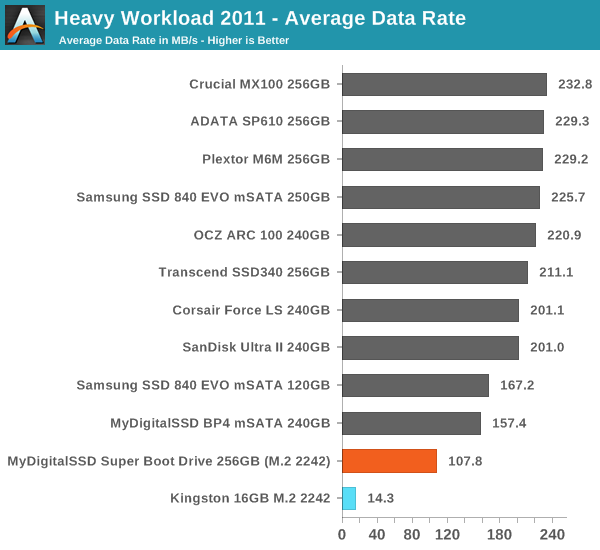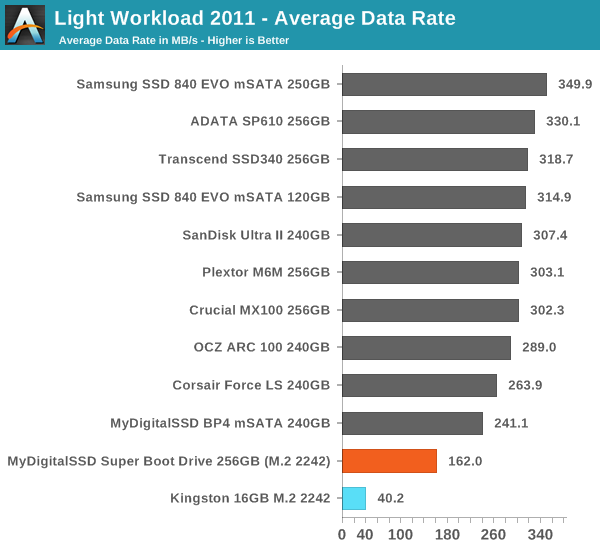Upgrading the SSD in Chromebook & MyDigitalSSD Super Boot Drive M.2 2242 SSD Review
by Kristian Vättö on October 21, 2014 8:00 AM ESTAnandTech Storage Bench 2011
Back in 2011 (which seems like so long ago now!), we introduced our AnandTech Storage Bench, a suite of benchmarks that took traces of real OS/application usage and played them back in a repeatable manner. The MOASB, officially called AnandTech Storage Bench 2011 – Heavy Workload, mainly focuses on peak IO performance and basic garbage collection routines. There is a lot of downloading and application installing that happens during the course of this test. Our thinking was that it's during application installs, file copies, downloading and multitasking with all of this that you can really notice performance differences between drives. The full description of the Heavy test can be found here, while the Light workload details are here.

In our 2011 Storage Benches the performance is not as good, though. It seems that the limited channel count is not that much of a bottleneck in worst-case scenario, but it certainly limits the peak performance as we can see here. However, I also included the 16GB Kingston M.2 that came in the Chromebook for comparison and the performance difference is tremendous.











67 Comments
View All Comments
pSupaNova - Wednesday, October 22, 2014 - link
No he is correct, Microsoft did not want netbooks to succeed.While Intel tried to Gimp their graphics and even stopped Nvidia ION project from improving the graphics situation
This mistake let tablets have an easier ride and now Nvidia has a remarkable SOC in the K1 thats going to eat Intel alive in the coming years.
jabber - Wednesday, October 22, 2014 - link
Netbooks were awful. They deserved to die. I ended up refusing to fix or work on them for customers. They would bring them to me saying "this is slow!" I would reply "It's because it IS slow!"Poor user experience and a waste of money. A novelty that should never have survived longer than a few months.
mike8675309 - Tuesday, October 21, 2014 - link
There were two specific problems. #1 - slow hard drives. #2 - no hardware video acceleration. With the Atom chip and slow drives with no hardware video acceleration, you have what is sitting in my basement and is effectively useless.hojnikb - Tuesday, October 21, 2014 - link
And its pretty much possible to make one for 150-200$, since windows licenses are free with cheap devices and Intel tablet SoC are selling for peanuts.Eeebook x205 is an example of that.
inmytaxi@gmail.com - Sunday, November 2, 2014 - link
The 10 inch laptop form factor is dead for windows, replaced by 10 - 11.6 inch tablets many with removable or flip-able keyboards.sligett - Tuesday, October 21, 2014 - link
All my users of HP 3105m netbooks (with AMD e-350 processors, and SSD or HDD) chose to move to Chromebooks when they were offered to them. In the schools where I work, a Windows laptop would have to be LESS expensive than a Chromebook to be attractive. In fact, a $200 Chromebook is in many ways more appealing than a free Windows laptop.RU482 - Tuesday, October 21, 2014 - link
My 12yr old daughter would object to your statement about AMD Brazos. I'll agree, when I bought the Lenovo Netbook that had the E-350 CPU for my traveling notebook/netbook, it was miles ahead of the Atom Z520 based Asus netbook that it replaced.Fast forward to 2014, the Lenovo has been handed down to my daughter, who likes to watch Netflix or play flash games on it. She's recently started to complain about how laggy the Lenovo has become. SSD health and free space are still good, wifi signal strength 5 bars....not sure what the excuse is, maybe she's used mom's i5 Haswell laptop too much! I'd say it's time to retire the Lenovo Brazos machine
Michael Bay - Wednesday, October 22, 2014 - link
In any netbook article one can expect a couple of sad AMD fanatics with drivel like that.Wake up, Brazos was hot as all hell and didn`t deliver anything Atom couldn`t.
waldojim42 - Thursday, October 23, 2014 - link
Yes, they most certainly did. Video acceleration and useful CPU performance. AMD made netbook CPU's that had significantly higher IPC at a cost of higher power usage.savagemike - Tuesday, October 21, 2014 - link
It's pretty easy to dual or co-boot linux on a Chromebook, and honestly that would be about the only good reason to upgrade storage to this kind of capacity. It would, of course, provide a whole host of tools/programs which would address some of the drawbacks you mention.That makes sense as desktop Linux, like Windows or OSX, are designed for a traditional local storage centric paradigm, where the ChromeOS devices of course are not.
The one true fault of the ChromeOS file explorer within its own context is the lack of local network integration. You really should be able to see/use shares on a LAN from the files app on a ChromeOS device and you can't.